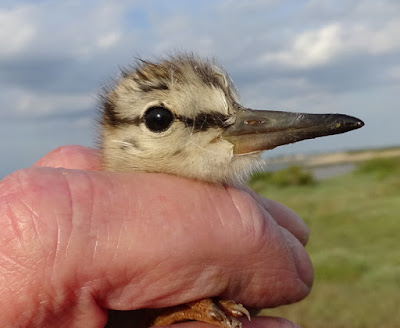Whilst checking the saltmarsh lagoons near the East Mersea Point on Thursday 18th, this redshank chick, probably about three weeks old, was rescued by Ian Black of Natural England after it dropped into a deep rill in the saltmarsh. It was lifted back up to the main body of marsh where it could continue feeding.
Along with Ian's colleague from Natural England Nicola George, we were having a close look at the saltmarsh to find out if there were any clues as to why the nine or so pairs of avocet had stopped nesting a few days ago. No reason could be seen but at least three avocets were still feeding on one of the lagoons
The kestrels in the nestbox have at least two chicks that showed on Wednesday 17th. The Cetti's warbler was singing well from the hedge along from the pond and a Mediterranean gull flew over the car park.
A cuckoo flew along Bromans Lane at dusk on Thursday.
At least two painted ladies were seen on this cotoneaster bush at the park on Thursday. Another two were feeding on the cotoneaster bush by the toilets the day before.
Numbers of meadow browns have quickly increased in the recent weather this week with the first one seen on Tuesday followed by about twenty on Thursday over the meadow.
This cotoneaster bush was planted nearly 25 years ago and has become a real magnet at the moment for the bees and butterflies. Other butterflies seen here were red admiral, holly blue and small tortoiseshell.while speckled wood, small white and large white were noted around the park.
An old woodpecker hole in an oak tree at the park has been colonised by tree bumble bees, the species which has been spreading across the country from Europe in recent years.
The wild flower meadow is coming to life with these ox-eye daisies adding some colour, while birds-foot trefoil and clumps of knapweed are ready to add more colour to the area.
Four common blues, small/Essex skipper, small heath and cinnabar a Mother Shipton were noted amongst the flowers, while a broad-bodied chaser and emperor dragonfly were also noted at the park.
The much warmer night on Saturday was ideal for moth activity and the highlight from the Firs Chase moth trap was this very colourful elephant hawkmoth. This common and widespread moth should be a regular visitor to the trap over the next few weeks.
The most unexpected moth was this pretty red-necked footman, a species that has not been recorded on the Island before in the ten previous years worth of trapping. Although it is a breeder in some of the woods in Essex, it is also an immigrant, and this one probably came in with the recent warm weather.
Eighty moths of twenty-five species were seen including heart and dart, marbled minor, middle-barred minor, dark arches, flame, figure of eighty, snout, spectacle, common swift, garden carpet, riband wave, foxglove pug, common marbled carpet, grey pine carpet, pale oak beauty, brimstone, small dusty wave, light emerald,
A mothing evening at the park on Tuesday night produced just twenty moths including poplar hawkmoth, a peppered moth and a brown rustic were of interest.
Two turtle doves were seen in Adrian Amos's West Mersea garden on Sunday 14th with a single bird the previous day.










No comments:
Post a Comment